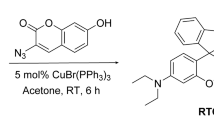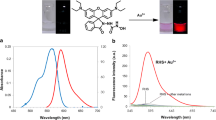Abstract
A novel probe RB for discriminative detection of Hg2+ and Cu2+ constructed by rhodamine and BODIPY was designed and synthesized. Probe RB consists of three parts: BODIPY as the energy donor, rhodamine as the energy receptor, and thiosemicarbazide as the reacting site. Probe RB selectively binds with Hg2+ and Cu2+ ions in in EtOH/H2O (V/V = 1:1) among tested metal ions. Probe RB exhibited a fluorescence red shift from 513 to 593 nm for Hg2+ and a fluorescence quenching for Cu2+. The mechanism study showed that the fluorescence changes of probe RB after the addition of Hg2+ was due to oxadiazole formation when the thiosemicarbazide moiety was liberated by Hg2+-facilitated ring opening of the spirocyclic group, while Cu2+ not only opened the spirolactam ring, but also bonded to the opening product through 1:2 mode. It is worth noting that all these types of probes could only detect Hg2+ or Cu2+ through metal ions-facilitated ring opening of the spirocyclic group mechanism. To the best of our knowledge, probe RB was firstly reported to detect Hg2+ and Cu2+ discriminatively. Moreover, probe RB demonstrated excellent sensitivity toward Hg2+ (LOD 8.36 nM) and Cu2+ (LOD 0.16 μM), fast responsive time (within 30 s) and wide pH range (6.0–10.0 for Hg2+, 6.0–11 for Cu2+). This probe was further successfully applied to Hela cells and could easily discriminate Hg2+ and Cu2+ through double-channel imaging.











Similar content being viewed by others
References
Beija M, Afonso CAM, Martinho JMG (2009) Synthesis and applications of Rhodamine derivatives as fluorescent probes. Chem Soc Rev 38:2410–2433. https://doi.org/10.1039/B901612K
Chen CG, Vijay N, Thirumalaivasan N, Velmathi S, Wu SP (2019) Coumarin-based Hg2+ fluorescent probe: Fluorescence turn-on detection for Hg2+ bioimaging in living cells and zebrafish. Spectrochim Acta A Mol Biomol Spectrosc 219:135–140. https://doi.org/10.1016/j.saa.2019.04.048
Chen SX, Zhang SS, Ruhan A, Han YF (2020) A new rhodamine probe with large stokes shift for Hg2+ detection and its application in real sample analysis. Tetrahedron Lett 61(27):152077. https://doi.org/10.1016/j.tetlet.2020.152077
Culzoni MJ, Pea AMDL, Machuca A, Goicoechea HC, Babiano R (2012) Rhodamine and bodipy chemodosimeters and chemosensors for the detection of Hg2+, based on fluorescence enhancement effects. Anal Methods 5:30–49. https://doi.org/10.1039/C2AY25769F
Divya D, Thennarasu S (2020) A novel isatin-based probe for ratiometric and selective detection of Hg2+ and Cu2+ ions present in aqueous and environmental samples. Spectrochim Acta Part A Mol Biomol Spectrosc 243:118796. https://doi.org/10.1016/j.saa.2020.118796
Du JH, Zhao B, Kan W, Yin HC, Song TS, Wang LY, Sun L, Wang XW, Yin GM, Wang JX (2021) A phenanthrene[9,10-d]imidazole-phenol-based fluorescent probe combining ESIPT and AIE for the ‘“turn-on”’ detection of Cu2+ with green-emission and improved Stokes’ shift, and its application. New J Chem 45:15415–15422. https://doi.org/10.1039/d1nj02177j
Duong TQ, Kim JS (2010) Fluoro- and chromogenic chemodosimeters for heavy metal ion detection in solution and biospecimens. Chem Rev 110(10):6280–6301. https://doi.org/10.1021/cr100154p
Hosseini MJ, Shaki F, Ghazi-Khansari M, Pourahmad J (2014) Toxicity of copper on isolated liver mitochondria: impairment at complexes i, ii, and iv leads to increased ros production. Cell Biochem Biophys 70(1):367–381. https://doi.org/10.1007/s12013-014-9922-7
Hu JW, Yu XL, Zhang X, Jing CC, Liu TT, Hu XC, Lu SL, Uvdal K, Gao HW, Hu ZJ (2020) Rapid detection of mercury (II) ions and water content by a new rhodamine B-based fluorescent chemosensor. Spectrochim Acta Part A Mol Biomol Spectrosc 241:118657. https://doi.org/10.1016/j.saa.2020.118657
Huang JL, Ma XW, Liu B, Cai LB, Li Q, Zhang YQ, Jiang KZ, Yin SC (2013) A colorimetric and ratiometric turn-on bodipy-based fluorescent probe for double-channel detection of Cu2+ and Hg2+. J Lumin 141:130–136. https://doi.org/10.1016/j.jlumin.2013.03.038
Huang Y, Li CF, Shi WJ, Tan HY, He ZZ, Zheng LY, Liu FG, Yan JW (2019) A near-infrared BODIPY-based fluorescent probe for ratiometric and discriminative detection of Hg2+ and Cu2+ ions in living cells. Talanta 198:390–397. https://doi.org/10.1016/j.talanta.2019.02.012
Ji RX, Liu AK, Shen SL, Cao XQ, Li F, Ge YQ (2017) An indolizine–rhodamine based FRET fluorescence sensor for highly sensitive and selective detection of Hg2+ in living cells. RSC Adv 7(65):40829–40833. https://doi.org/10.1039/C7RA07938A
Kaur P, Singh K (2019) Recent advances in the application of BODIPY in bioimaging and chemosensing. J Mater Chem C 7:11361–11405. https://doi.org/10.1039/C9TC03719E
Ko KS, Yang YK, Tae JS, Shin I (2006) In vivo monitoring of mercury ions using a rhodamine-based molecular probe. J Am Chem Soc 128(43):14150–14155. https://doi.org/10.1021/ja065114a
Kowada T, Maeda H, Kikuchin K (2015) BODIPY-based probes for the fluorescence imaging of biomolecules in living cell. Chem Soc Rev 44:4953–4972. https://doi.org/10.1039/C5CS00030K
Li YZ, Qi SJ, Xia CC, Xu YH, Duan GY, Ge YQ (2019) A FRET ratiometric fluorescent probe for detection of Hg2+ based on an imidazo[1,2-a]pyridine-rhodamine system. Anal Chim Acta 1077:243–248. https://doi.org/10.1016/j.aca.2019.05.043
Li CP, Niu QF, Wang JG, Wei T, Li TD, Chen JB, Qin XY, Yang QX (2020) Bithiophene-based fluorescent sensor for highly sensitive and ultrarapid detection of Hg2+ in water, seafood, urine and live cells. Spectrochim Acta Part A Mol Biomol Spectrosc 233:118208. https://doi.org/10.1016/j.saa.2020.118208
Lian J, Xu Q, Wang Y, Meng F (2020) Recent developments in fluorescent materials for heavy metal ions analysis from the perspective of forensic chemistry. Front Chem 8:593291. https://doi.org/10.3389/fchem.2020.593291
Lin CX, Zhang M, Yan XQ, Zhang RQ, He XJ, Yuan YF (2020) A coumarin-boronic based fluorescent “on-off” probe for Hg2+ in aqueous solution. Z Anorg Allg Chem 646:1892–1899. https://doi.org/10.1002/zaac.202000135
Liu B, Liu J, He J, Zhang J, Gao C (2020a) A novel red-emitting fluorescent probe for the highly selective detection of Hg2+ ion with AIE mechanism. Chem Phys 539:110944. https://doi.org/10.1016/j.chemphys.2020.110944
Liu YL, Yang L, Li L, Liang XM, Li SJ, Fu Y (2020b) A dual thiourea-appended perylenebisimide “turn-on” fluorescent chemosensor with high selectivity and sensitivity for Hg2+ in living cells. Spectrochim Acta Part A Mol Biomol Spectrosc 241:118678. https://doi.org/10.1016/j.saa.2020.118678
Nagarajan R, Varadaraju C, Lee KH (2021) Recent advancements in the role of n-heterocyclic receptors on heavy metal ion sensing. Dyes Pigm 191:109331. https://doi.org/10.1016/j.dyepig.2021.109331
Nguyen VN, Ha J, Cho M, Li HD, Swamy KMK, Yoon J (2021) Recent developments of BODIPY-based colorimetric and fluorescent probes for the detection of reactive oxygen/nitrogen species and cancer diagnosis. Coord Chem Rev 439:213936. https://doi.org/10.1016/j.ccr.2021.213936
Petdum A, Faichu N, Sirirak J, Khammultri P, Wanichacheva N (2020) [5]helicene-rhodamine 6 g hybrid-based sensor for ultrasensitive Hg2+ detection and its biological applications. J Photochem Photobiol, A 394:112473. https://doi.org/10.1016/j.jphotochem.2020.112473
Saleem M, Lee KH (2014) Selective fluorescence detection of Cu2+ in aqueous solution and living cells. J Lumin 145:843–848. https://doi.org/10.1016/j.jlumin.2013.08.044
Shi WJ, Li CF, Huang Y, Tan HY, Wei YF, Liu FG, Feng LX, Zheng LY, Chen GS, Yan JW (2019) A remarkable colorimetric probe for fluorescent ratiometric and ON-OFF discriminative detection of Hg2+ and Cu2+ by double-channel imaging in living cells. Dyes Pigments 171:107782. https://doi.org/10.1016/j.dyepig.2019.107782
Slassi S, Aarjane M, Amine A (2021) A novel imidazole-derived schiff base as selective and sensitive colorimetric chemosensor for fluorescent detection of Cu2+ in methanol with mixed aqueous medium. Appl Organomet Chem 35:e6408. https://doi.org/10.1002/aoc.6408
Tetsuro A, Takashi K, Hisato I,In Monirith, Touch Seang T, Annamalai S, Shinsuke T (2005) Mercury contamination in human hair and fish from cambodia: levels, specific accumulation and risk assessment. Environ Pollut 134(1):79–86. https://doi.org/10.1016/j.envpol.2004.07.015
Wang M, Wen J, Qin ZH, Wang HM (2015) A new coumarine-rhodamine FRET system as an efficient ratiometric fluorescent probe for Hg2+ in aqueous solution and in living cells. Dyes Pigments 120:208–212. https://doi.org/10.1016/j.dyepig.2015.04.013
Wen D, Deng XK, Xu GV, Wu HR, Yu YH (2021) A novel FRET fluorescent probe based on BODIPY- rhodamine system for Hg2+ imaging in living cells. J Mol Struct 1236:130323. https://doi.org/10.1016/j.molstruc.2021.130323
Yang YK, Yook KJ, Tae JS (2005) A rhodamine-based fluorescent and colorimetric chemodosimeter for the rapid detection of Hg2+ ions in aqueous media. J Am Chem Soc 127(48):16760–16761. https://doi.org/10.1021/ja054855t
Yang Y, Zhao Q, Feng W, Li F (2013) Luminescent chemodosimeters for bioimaging. Chem Rev 113(1):192–270. https://doi.org/10.1021/cr2004103
Yang CC, Li YY, Wu N, Zhang YC, Feng W, Yu MM, Li ZX (2021) Ratiometric upconversion luminescence nanoprobes for quick sensing of Hg2+ and cells imaging. Sens Actuators, B Chem 326:128841. https://doi.org/10.1016/j.snb.2020.128841
Zhang QY, Wong KMC (2020) Photophysical, ion-sensing and biological properties of rhodamine-containing transition metal complexes. Coord Chem Rev 416:213336. https://doi.org/10.1016/j.ccr.2020.213336
Zhang L, Zhang XH (2014) A selectively fluorescein based colorimetric probe for detecting copper(II) ion. Spectrochim Acta Part A Mol Biomol Spectrosc 133:54–59. https://doi.org/10.1016/j.saa.2014.04.130
Zhang RQ, Yan FY, Huang YC, Kong DP, Ye QH, Xu JX, Chen L (2016) Rhodamine-based ratiometric fluorescent probes based on excitation energy transfer mechanisms: construction and applications in ratiometric sensing. RSC Adv 6:50732–50760. https://doi.org/10.1039/C6RA06956H
Zhang J, Wang NN, Ji X, Tao YF, Wang JM, Zhao WL (2020) BODIPY-Based fluorescent probes for biothiols. Chem: A Eur J 26(19):4172–4192. https://doi.org/10.1002/chem.201904470
Zhang CL, Zhang Y, Li MX, Gong S, Gao Y, Yang YQ, Wang ZL, Wang SF (2021) A novel AIE fluorescent probe based on myrtenal for Cu2+ detection in a near-perfect aqueous medium and bioimaging in vegetables and zebrafish. New J Chem 45(34):15247–15254. https://doi.org/10.1039/D1NJ02662C
Zhao D, Zhang XN, Li XF, Ru SG, Wang YW, Yin JB, Liu DS (2018) Oxidative damage induced by copper in testis of the red swamp crayfish procambarus clarkii and its underlying mechanisms. Aquat Toxicol 207:120–131. https://doi.org/10.1016/j.aquatox.2018.12.006
Zhu ZF, Ding HC, Wang YS, Fan CB, Tu YY, Liu G, Pu SZ (2020) A ratiometric and colorimetric fluorescent probe for the detection of mercury ion based on rhodamine and quinoline–benzothiazole conjugated dyad. J Photochem Photobiol, A 400:112657. https://doi.org/10.1016/j.jphotochem.2020.112657
Zhu DJ, Jiang SL, Zhao W, Yan XW, Xie W, Xiong YH, Wang SJ, Cai W, Gao YJ, Ren AS (2021) A novel ratiometric fluorescent probe for sensitive and selective detection of Cu2+ based on Boranil derivatives. Inorg Chim Acta 542:120438. https://doi.org/10.1016/j.ica.2021.120438
Acknowledgements
Thanks for the support of Jianghan University Foundation (2021KJZX001).
Author information
Authors and Affiliations
Corresponding authors
Ethics declarations
Conflict of interest
The authors declare that they have no known competing financial interests or personal relationships that could have appeared to influence the work reported in this paper.
Additional information
Publisher's Note
Springer Nature remains neutral with regard to jurisdictional claims in published maps and institutional affiliations.
Supplementary Information
Below is the link to the electronic supplementary material.
Rights and permissions
Springer Nature or its licensor holds exclusive rights to this article under a publishing agreement with the author(s) or other rightsholder(s); author self-archiving of the accepted manuscript version of this article is solely governed by the terms of such publishing agreement and applicable law.
About this article
Cite this article
Ma, L., Xu, G., Deng, X. et al. A dual-channel chemosensor based on rhodamine and BODIPY conjugated dyad for ratiometric detection of Hg2+ and fluorescence on–off recognition of Cu2+ in aqueous solution and living cells. Chem. Pap. 77, 583–593 (2023). https://doi.org/10.1007/s11696-022-02504-6
Received:
Accepted:
Published:
Issue Date:
DOI: https://doi.org/10.1007/s11696-022-02504-6




